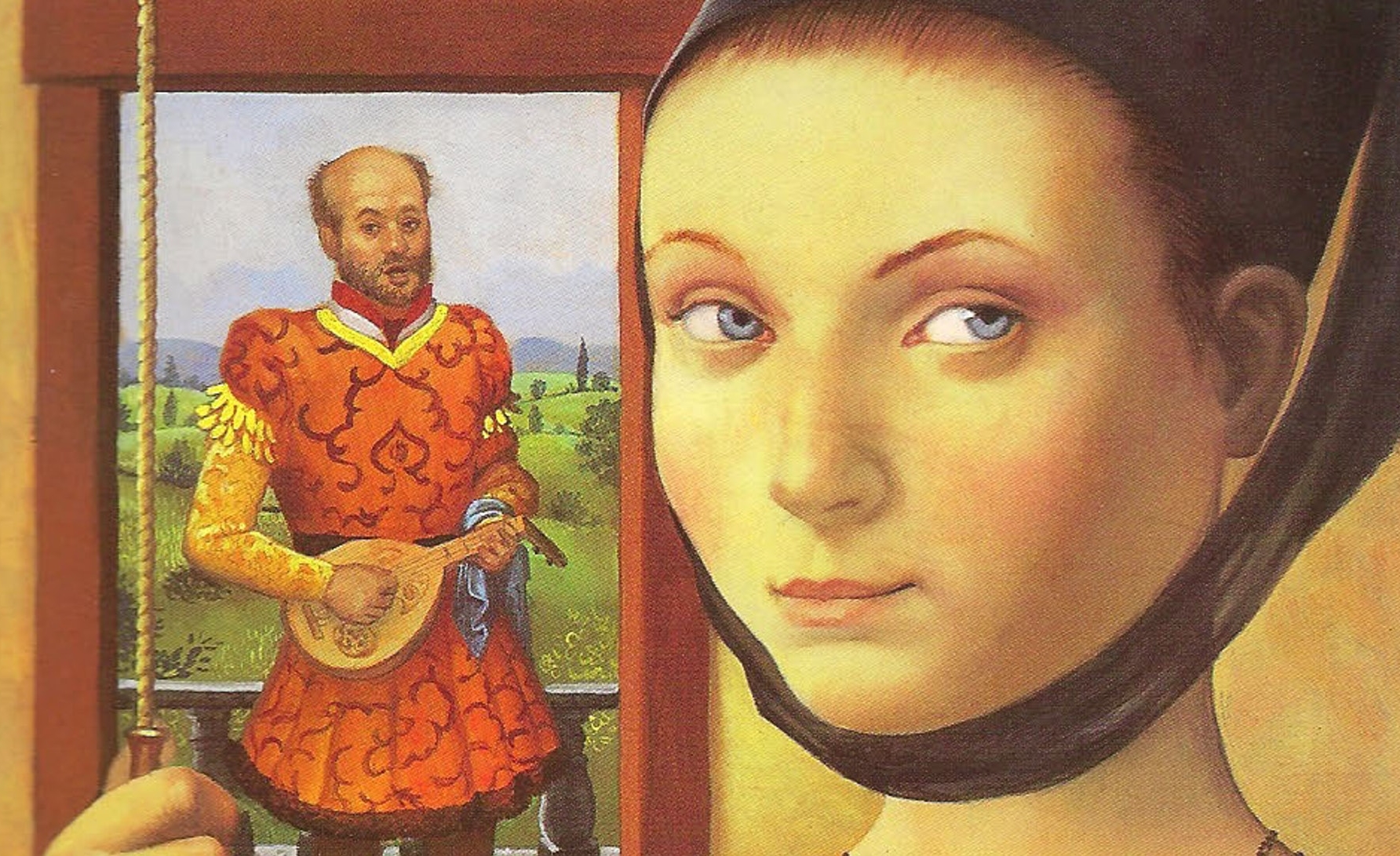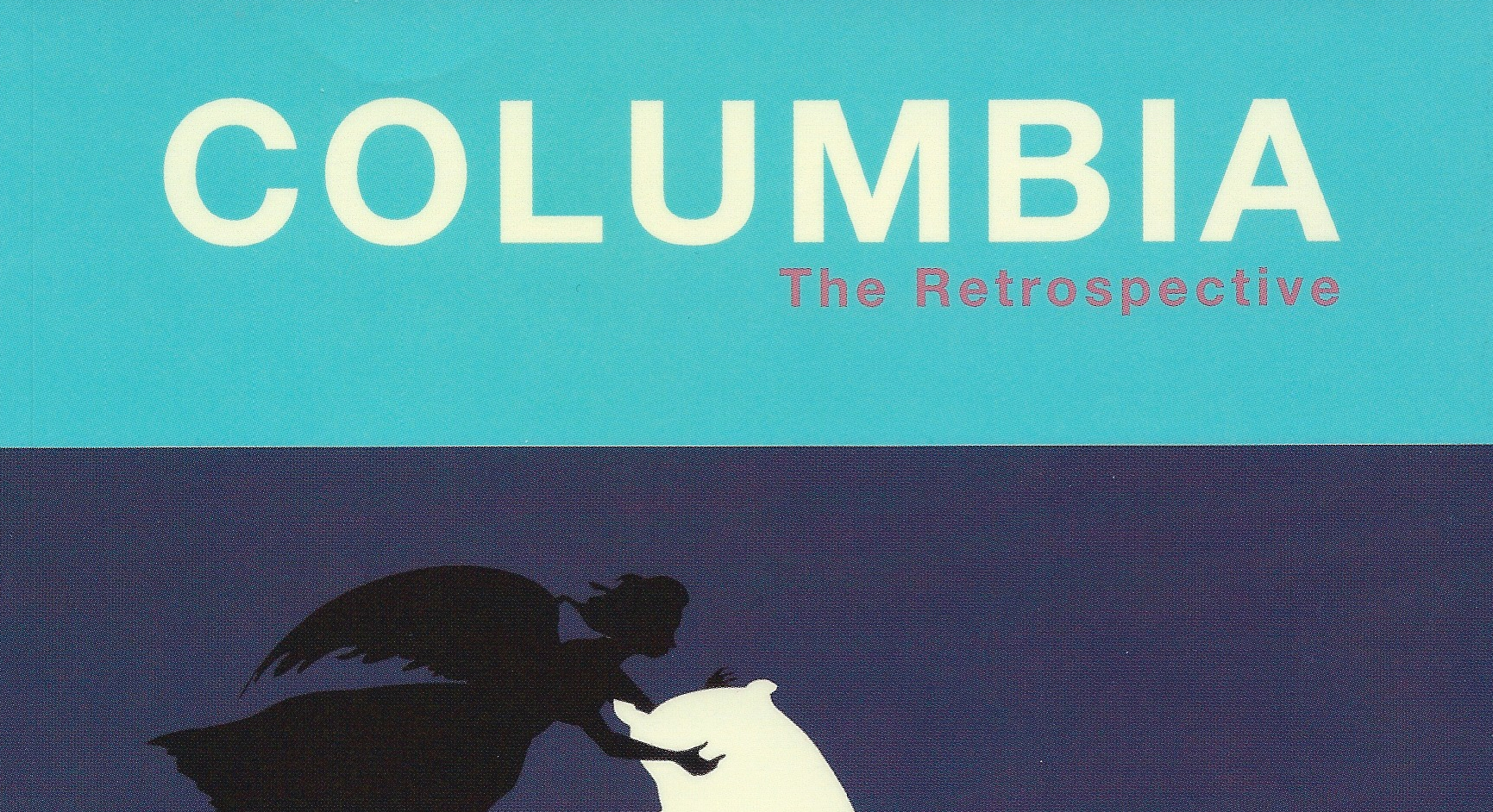Canon Fodder is an ongoing series of essays where writers talk about the books they’ve held close relationships with in their lives and why those books deserve a second read by a broader literary audience.
As an eleven-year-old, I knew Catherine, Called Birdy by its cover. I first saw it propped up on a shelf at a Scholastic book fair back in the early 2000s. My first memory of the cover was that it seemed old-fashioned: a fair-skinned young woman with piercing blue eyes who stared just beyond the viewer conspiratorially. In the background, I saw a man playing a lute, presumably her suitor. I only decided to give the book a try once I had taken a closer look to see that the girl was actually holding a rope attached to a bucket of water, about to be dumped on her suitor’s head.
Catherine, Called Birdy by Karen Cushman is a young adult novel published in 1994. Set in 1290, thirteen-year-old Catherine (a.k.a. Birdy) is the daughter of a minor nobleman in Britain who keeps a diary at the urging of her brother, a monk. Though it was rare for even noble women to have kept diaries at this time, Catherine does so, keeping record of her daily life. Along with detailing the day-to-day duties she loathes and must endure, including sewing, embroidering, and making “remedies” to doctor those around her, the reader follows Catherine’s interactions with the villagers her father presides over. These duties are meant to make her a good wife, and her father actively seeks a potential husband for her. Catherine foils his plans by pulling pranks on her suitors when they visit, most notably setting the outdoor privy, or outhouse, on fire. Instead of marriage, she daydreams of a life as an adventurer, a wart charmer (though it’s not entirely clear what a wart charmer actually does), a monk, a minstrel, or even one of the villagers, who she thinks have far more choice over who they marry. She often invokes the caged birds she keeps as pets. Like her birds, she longs for a future outside of the manor. While the symbol is a cliché, it fits the strange, grimy, almost foreign medieval world Catherine inhabits. Though her life is restricted in many ways by her status and the isolated nature of the medieval world (when her mother gives a group of Jews shelter for a night, Catherine marvels that they “have no horns or tails”), every entry is steeped in vivid imagination, deep wit, and profound contempt for her place in society.
The form of a diary is an obvious choice for a novel aimed at young adults. After all, the diary format gives the plot forward momentum by detailing daily events and developments. The inherent privacy lends itself to emotional intimacy. Catherine marks the passage of time by highlighting whichever Saint’s Day is to be celebrated, along with their sacred life achievements and/or horrific deaths. Catherine, Called Birdy was hardly the first “diary-like” book I’d read. But this novel was the first instance where I felt connected to a teenage girl from a bygone era through her diary. Her angst over her parents deciding her future for her, the loneliness of dull work alone in her room, and her daydreams for adventure were something I could understand, even with the tapestries on her walls and the looming threat of an arranged marriage.
When I first read this novel in middle school, I was struck that while the book does involve romance, specifically how romantic love may or may not coincide with arranged marriage, finding true love is not Catherine’s only objective. At the time, it was one of the only young adult books I’d read, at least featuring a female protagonist, where finding “true love” was not the main focus of the narrative. Though Catherine does have crushes, and the plot’s central tension is her impending arranged marriage, the diary is ultimately about the daily drudgery of medieval life and her vast interior landscape despite crushing monotony. True love as a concept tempts her, but is not her end goal. Her daily actions drive the plot and her innermost thoughts and feelings provide depth, but the ending provides no satisfying answer as to whether Catherine will actually experience requited, romantic love. This idea was revolutionary to me upon first reading, even if it seems commonplace today.
I also remembered it being hilarious. Rereading the book as an adult now, it is every bit as funny and poignant as I recall it being from my middle school years. Catherine is hysterical and relatable, even if the medieval cultural context is not. Her wry observations, interior monologue, and constant bickering with her father made it no surprise for me to learn that Lena Dunham obtained the film rights to the novel in 2014. Catherine’s voice is modern, anachronistically so, but it is satisfying nonetheless. As I reread on the subway and laughed aloud, I remembered Virginia Woolf’s famous line from the essay “A Room of One’s Own”: “For most of history, Anonymous was a woman.” Cushman’s rendering of Catherine appears to put that quote into practice and consider what the life of Anonymous may have looked like: a privileged woman who received just enough education to make her a more dutiful wife (and writer).
Catherine’s struggle to assert control over her future still rings alarmingly true today. Her refusal to marry the “smelly, broken-toothed old man” she refers to as Shaggy Beard feels all too contemporary. I had forgotten, or perhaps never fully understood, how much consent plays into the tension between her and her father: “But it occurred to me what actually makes people married is not the church or the priest but their consent, their ‘I will.’” As a pre-teen reader, this seemed like a case of adults making decisions about kids’ lives, because they can. But upon rereading, the importance of agency and Catherine’s self-awareness added a darker layer to its meaning. As Catherine reminds her father, he is selling her “like a piece of cheese for [his] profit.” These lines take on new significance as an adult reader because I can now feel, and better understand, the weight of her oppression. Catherine is aware of her own objectification, and understands that if she is to follow her father’s orders, her consent to this marriage will be, to some degree, coerced.
The book ends with the news that Shaggy Beard died in a brawl mere days before the wedding, but it is determined Catherine will still have to marry his son. The diary cuts off at this point. All the reader knows about this marriage candidate is that he is closer to her age and gives her thoughtful gifts. As she mentions, like her beloved birds still confined in her room, “In any event, I am, if not free, at least less painfully caged.”
This was a surprising ending when I was eleven years old. What I understand now, but did not understand then, is that there is no prince charming waiting for Catherine. There is merely the “good enough” ending, a patriarchal arrangement that still objectifies her but may be slightly less cruel (though it remains unclear whether Shaggy Beard’s son is, in fact, less vile than his father). Though young women in Western cultures are, for the most part, allowed far more freedoms today, Catherine’s compromise for the “good enough” suitor was dissatisfying to me as a teenager because I was accustomed to love stories with happy endings. Her fate broke my heart as an adult, but it also felt inevitable. I could see there was never going to be a happy ending for her, not by today’s standards. It was merely a reminder for me that for all our progress, many young women may still choose to settle for the “less painfully caged” partner, career, or ideology.
Young adult and children’s literature has changed considerably since the initial publication of Catherine, Called Birdy, and I did find myself cringing at certain moments while rereading the book today. Catherine’s father regularly beats her, which is disturbing, but is considered in the book a humorous if crass detail (something I didn’t find funny as an adult reader). There has been a rightful and refreshing shift towards being more inclusive in YA since this book’s publication, with protagonists who reflect a far broader range of races, ethnicities, religions, gender identities, and sexualities. Catherine is white, straight, and affluent. Yet the time period of the novel also restricts possible protagonists, as few non-noble people in Western society would have been able to read and write as she did. A nobleman’s daughter who thought and acted as Catherine did (though most, as Cushman points out in the epilogue, would not have) would have seen herself as caged, even if, to the feudal villagers, she had power, privilege, and money. The limitations of the novel are what made it engaging for me as both a teenager and an adult: I am allowed a glimpse of an impenetrable past through the eyes of a heroine who seems to reflect my modern attitude. It may not be historically accurate, but it did make me question how free I really am in my own choices so many centuries later.
Though the book makes a case for how far women had come in the early 1990s, today it reads as a necessary reminder of just how far we still need to go. As the book turns 25, it begs the question: how often do we still compromise? How often do we exercise our agency? When do we give our consent fully, unequivocally? Most importantly, how caged are we still, and if we are still caged, what do our cages look like today? While it is not perfect, Catherine’s witty voice, full of heart and hope, is still a worthy contribution to the conversation.




